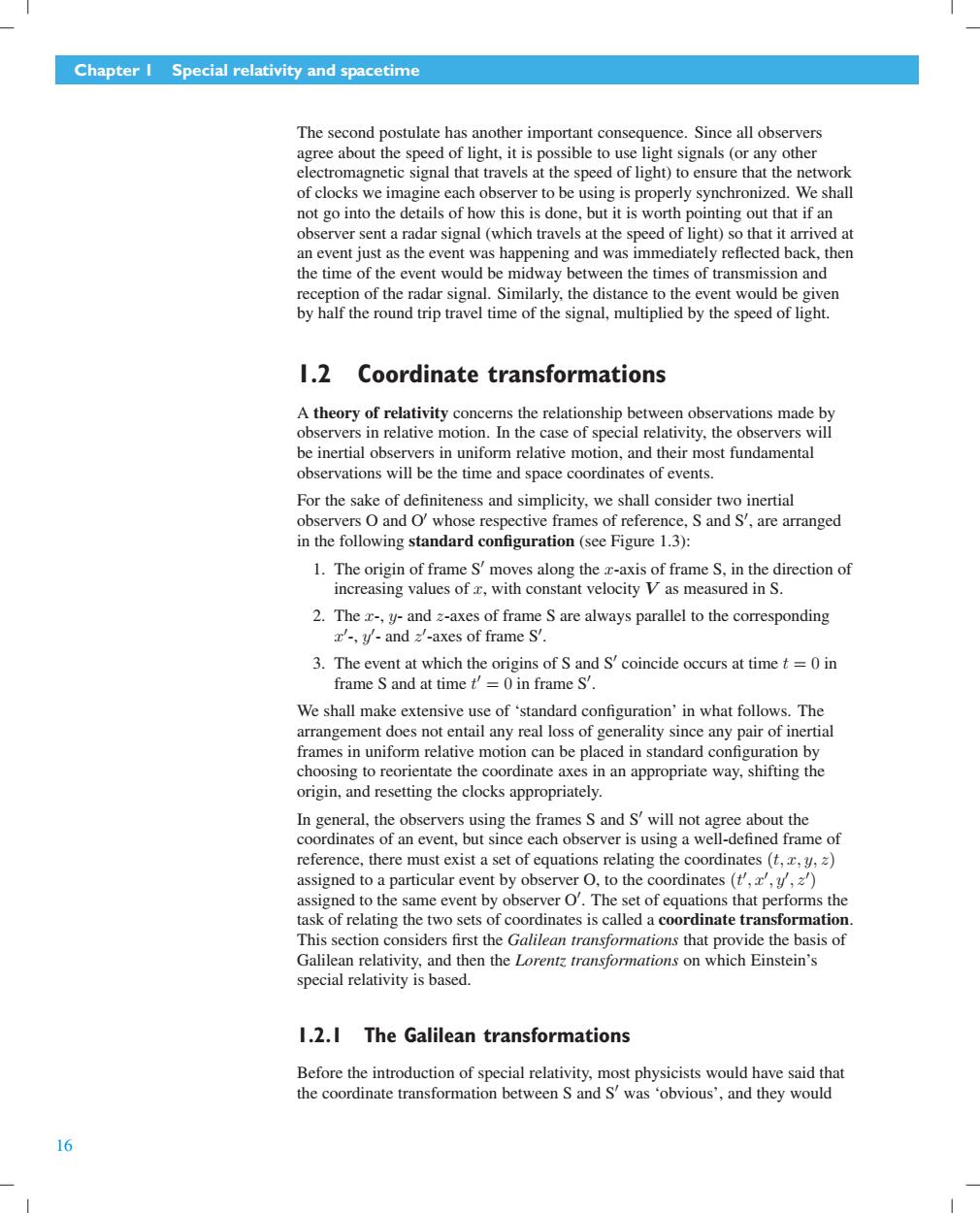正在加载图片...

Chapter I Special relativity and spacetime The second postulate has another important consequence.Since all observers agree about the speed of light,it is possible to use light signals(or any other electromagnetic signal that travels at the speed of light)to ensure that the network of clocks we imagine each observer to be using is properly synchronized.We shall not go into the details of how this is done,but it is worth pointing out that if an observer sent a radar signal (which travels at the speed of light)so that it arrived at an event just as the event was happening and was immediately reflected back,then the time of the event would be midway between the times of transmission and reception of the radar signal.Similarly,the distance to the event would be given by half the round trip travel time of the signal,multiplied by the speed of light. 1.2 Coordinate transformations A theory of relativity concerns the relationship between observations made by observers in relative motion.In the case of special relativity,the observers will be inertial observers in uniform relative motion,and their most fundamental observations will be the time and space coordinates of events. For the sake of definiteness and simplicity,we shall consider two inertial observers O and O'whose respective frames of reference,S and S',are arranged in the following standard configuration(see Figure 1.3): 1.The origin of frame S'moves along the c-axis of frame S,in the direction of increasing values of r,with constant velocity V as measured in S. 2.The x-,y-and z-axes of frame S are always parallel to the corresponding x'-,y-and z'-axes of frame S'. 3.The event at which the origins of S and S'coincide occurs at time t =0 in frame S and at time t'=0 in frame S'. We shall make extensive use of 'standard configuration'in what follows.The arrangement does not entail any real loss of generality since any pair of inertial frames in uniform relative motion can be placed in standard configuration by choosing to reorientate the coordinate axes in an appropriate way,shifting the origin,and resetting the clocks appropriately. In general,the observers using the frames S and S'will not agree about the coordinates of an event,but since each observer is using a well-defined frame of reference,there must exist a set of equations relating the coordinates (t,y,2) assigned to a particular event by observer O,to the coordinates (t',,,2) assigned to the same event by observer O'.The set of equations that performs the task of relating the two sets of coordinates is called a coordinate transformation. This section considers first the Galilean transformations that provide the basis of Galilean relativity,and then the Lorentz transformations on which Einstein's special relativity is based. 1.2.I The Galilean transformations Before the introduction of special relativity,most physicists would have said that the coordinate transformation between S and S'was 'obvious',and they would 16Chapter 1 Special relativity and spacetime The second postulate has another important consequence. Since all observers agree about the speed of light, it is possible to use light signals (or any other electromagnetic signal that travels at the speed of light) to ensure that the network of clocks we imagine each observer to be using is properly synchronized. We shall not go into the details of how this is done, but it is worth pointing out that if an observer sentaradar signal (which travels at the speed of light) so that it arrived at an event just as the event was happening and was immediately reflected back, then the time of the event would be midway between the times of transmission and reception of the radar signal. Similarly, the distance to the event would be given by half the round trip travel time of the signal, multiplied by the speed of light. 1.2 Coordinate transformations A theory of relativity concerns the relationship between observations made by observers in relative motion. In the case of special relativity, the observers will be inertial observers in uniform relative motion, and their most fundamental observations will be the time and space coordinates of events. For the sake of definiteness and simplicity, we shall consider two inertial observers O and O % whose respective frames of reference, S and S % , are arranged in the following standard configuration (see Figure 1.3): 1. The origin of frame S % moves along the x-axis of frame S, in the direction of increasing values of x, with constant velocity V as measured in S. 2. The x-, y- and z-axes of frame S are always parallel to the corresponding x % -, y % - and z % -axes of frame S% . 3. The event at which the origins of S and S % coincide occurs at time t = 0 in frame S and at time t % = 0 in frame S % . We shall make extensive use of ‘standard configuration’ in what follows. The arrangement does not entail any real loss of generality since any pair of inertial frames in uniform relative motion can be placed in standard configuration by choosing to reorientate the coordinate axes in an appropriate way, shifting the origin, and resetting the clocks appropriately. In general, the observers using the frames S and S% will not agree about the coordinates of an event, but since each observer is using a well-defined frame of reference, there must exist a set of equations relating the coordinates (t, x, y, z) assigned to a particular event by observer O, to the coordinates (t % , x% , y% , z% ) assigned to the same event by observer O% . The set of equations that performs the task of relating the two sets of coordinates is called a coordinate transformation. This section considers first the Galilean transformations that provide the basis of Galilean relativity, and then the Lorentz transformations on which Einstein’s special relativity is based. 1.2.1 The Galilean transformations Before the introduction of special relativity, most physicists would have said that the coordinate transformation between S and S % was ‘obvious’, and they would 16